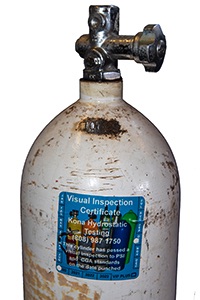
What is a visual inspection and why should I have one?
During a visual inspection a scuba cylinder is inspected on the inside and outside to standards set by the Compressed Gas Association (CGA) as well as standards set by The Professional Cylinder Inspectors (PCI/PSI formally PSI). The cylinders are inspected for bulges, dents, rust, other corrosion and other forms of damage that can weaken the scuba cylinder and make it unsafe to be used. The threads and neck of the cylinder are also inspected for corrosion and cracks to insure that the cylinder is safe to fill.
In addition 6351 aluminum cylinders made by Luxfer and Walter Kidde are required to have an additional test known as a Visual Eddy test. These cylinders were made of a different grade of aluminum than the newer cylinders and are susceptible to Sustained Load Cracks. A scuba cylinder that has neck cracks may fail violently when being filled and kill the fill station operator. A cylinder that has had a Visual Eddy test done during a Hydrostatic test will have VE stamped next to the hydrostatic test stamp.
Scuba cylinders are made out of either aluminum or steel. The valves are made out of chrome plated brass. Whenever you have two dissimilar metals in a saltwater environment electrolysis can occur and the two metals will try and become chemically welded together. At that point the valve will not come out when it needs to without damaging the cylinder. For this reason it is a good idea to remove the valve at least once a year and replace the o-rings and relubricate the threads. The burst disk should be replaced at least every five years, generally at the time of the Hydrostatic test.
Most dive operations will not fill a scuba cylinder that does not have a current visual inspection.
Great, what else can go wrong with my cylinder?
SCUBA cylinders as well as other cylinders (Oxygen, Fire Extinguishers and some SCBAs) generally will last a life time as long as they are taken care of. With the exception of the older 6351 aluminum cylinders which may have a birth defect, most other cylinders do not die a natural death.....they generally die from negligent homicide....they are murdered. As long as a scuba cylinder is never emptied while diving, water can not enter the cylinder and cause corrosion, however many people do use up all of their air, empty the cylinder and allow water into a cylinder. Water can also be introduced to a cylinder by poor compressor maintenance. This can cause steel cylinders to rust and die an early death. Water in an Aluminum cylinder can cause pitting and other forms of corrosion that eat away the threads. This also leads to an early death.
A cylinder that has rust or other corrosion in it may have to be "Tumbled" or "Whipped". Tumbling a cylinder involves putting an abrasive medium (such as ceramic chips) into the cylinder and having it rotate for a number of hours to help remove the corrosion so that it can be inspected properly. Whipping a cylinder, while it sounds worse, is a less severe cleaning method and is used on cylinders that only have minor corrosion. A special abrasive nylon whip is attached to a drill and the inside of the cylinder is cleaned of any minor corrosion.
Many people never, or rarely, rinse their scuba cylinders. This allows saltwater to sit at the top of the cylinder between the valve and cylinder and cause corrosion and cause the cylinder to die an early death.
Periodic valve maintenance is a must. The valve should be removed once a year for scuba, the o-rings should be replaced and it should be relubricated and reinstalled. Burst disks should be replaced at the time of the Hydrostatic test. The valve seat will have to be replaced occasionally to insure proper operation.
Proper cleaning and maintenance will help a cylinder last a long, long time.
My oldest scuba cylinder is a steel cylinder manufactured in 1953.
What to look for when buying used scuba cylinders.

